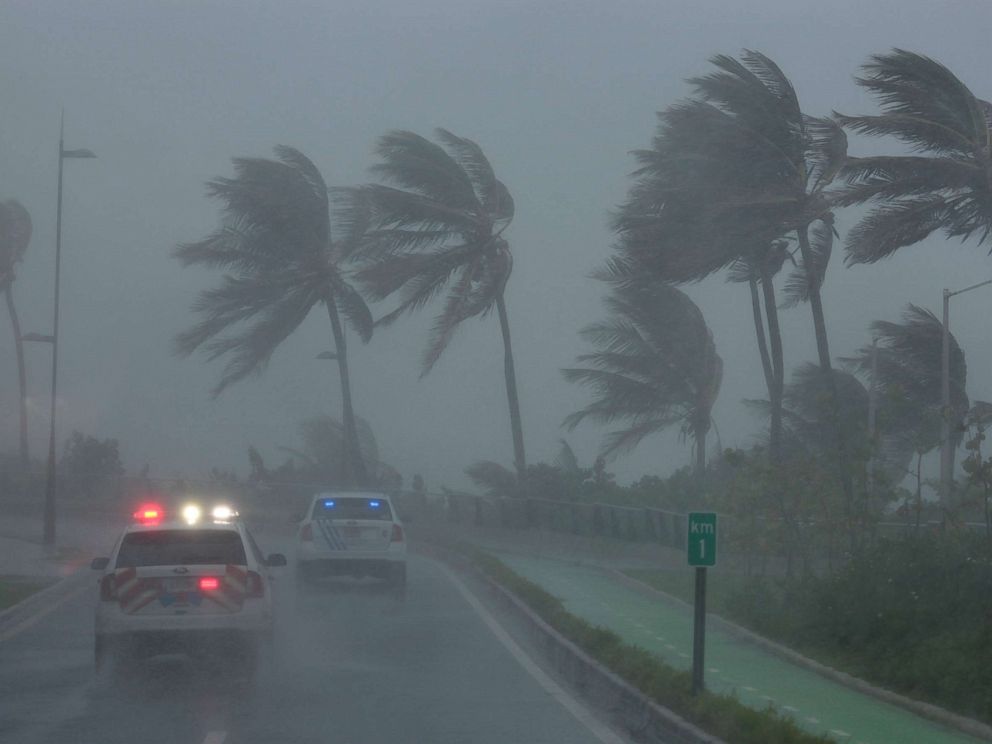
Hurricane Irma has caused widespread destruction across the Caribbean, reducing buildings to rubble and leaving at least nine people dead.
The small island of Barbuda is said to be “barely habitable”. Officials warn that St Martin is almost destroyed, and the death toll is likely to rise.
Irma, a category five hurricane, the highest possible level, is passing north of Puerto Rico.
Two other storms have strengthened to become hurricanes.
More than half of the island’s three million residents were without power as Irma caused heavy downpours and strong winds. Officials have said that power could be cut off for several days.
The most powerful Atlantic storm in a decade had wind speeds of 295km/h (185mph) and was expected to pass near or just north of the coast of the Dominican Republic on Thursday.
Hurricane Irma first hit the dual-island nation of Antigua and Barbuda. At least one death, of a child, was reported on Barbuda, where Prime Minister Gaston Browne said about 95% of the buildings had suffered some damage.
“It’s absolute devastation,” he said after flying over the island, home to some 1,600 people. “The island is literally under water. In fact, I’m of the view that, as it stands now, Barbuda is barely habitable.”
He told the BBC that 50% of the Barbuda population were now homeless and that it would cost $100m to rebuild the island.
However, Antigua, with a population of 80,000, escaped major damage, with no loss of life, he said earlier.
Officials have confirmed at least eight deaths and considerable damage in the French territories of St-Martin and Saint Barthélemy, popularly known as St Barts.
“It’s an enormous catastrophe – 95% of the island is destroyed,” top local official Daniel Gibbs was quoted as saying.
Significant damage was also reported in the Dutch section of St Martin, known as Sint-Maarten.
Sint-Maarten’s airport, the third largest in the Caribbean, has been destroyed.
The Dutch defence ministry said: “The picture is of many uprooted trees, houses without roofs and pleasure boats on land.”
The Dutch navy has sent two ships from nearby Aruba and Curacao to assist locals, according to media in the Netherlands.
US President Donald Trump said he and his aides were monitoring Irma’s progress. “But it looks like it could be something that will be not good. Believe me, not good,” he told reporters at the White House.
Projections suggest it could hit the state of Florida on Sunday.
Officials started evacuations of tourists and residents of Florida Keys, a resort archipelago.
Flights to and from several airports in Florida were being suspended, while Orlando’s international airport said that commercial flights would stop from 17:00 local time on Saturday.
A state of emergency had been declared for Florida, Puerto Rico and the US Virgin Islands, mobilising federal disaster relief efforts.
British Foreign Secretary Boris Johnson said the government was in touch with British overseas territories caught up in Irma, and was doing “everything we can to help those afflicted”.
Islands that have been hit by Irma
Antigua and Barbuda
- Population: 90,800
- Key facts: one of the Caribbean’s most prosperous nations, thanks to its tourism industry and offshore financial services
- Hurricane report: Antigua reportedly escaped major damage, with no loss of life, but some 95% of structures on Barbuda were damaged or destroyed, the prime minister says, confirming at least one death
St Martin
- Population: 75,000
- Key facts: tourist destination celebrated for its beaches; divided between France, which calls its section Saint Martin, and the Netherlands, which calls its part Sint-Maarten
- Hurricane report: at least six people reported killed in St Martin, according to the French interior minister. There has been serious damage to buildings, flooding, power cuts
St Barts (Saint Barthélemy)
- Population: 9,200
- Key facts: luxury tourist destination
- Hurricane report: two reported killed; serious damage to buildings, flooding, power cuts
Anguilla
- Population 13,500
- Key facts: British overseas territory and upmarket tourist destination
- Hurricane report: damage to buildings; extent as yet unknown
British Virgin Islands
- Population: 20,600
- Key facts: more than 40 islands and islets
- Hurricane report: Irma passed over the northern islands
Puerto Rico
- Population: 3.7 million
- Key facts: a tourist destination but plagued by debt, poverty and high unemployment
- Hurricane report: Irma passed close by; wide-spread power cuts; extent of damage not yet known
Islands still at risk from Irma
Dominican Republic
- Population: 10.2 million
- Key facts: major tourist destination, shares island of Hispaniola with Haiti
- Hurricane prediction: Irma expected to pass close by
Haiti
- Population: 10.2 million
- Key facts: on the same island as the Dominican Republic; devastated by an earthquake in 2010
- Hurricane prediction: not directly in the hurricane’s path, but remains on alert
Turks and Caicos
- Population: 31,500
- Key facts: enjoys one of the more dynamic economies in the region thanks to upmarket tourism, offshore finance and fishing
- Hurricane prediction: the low-lying region is at risk of a storm surge with destructive waves up to 6m (20ft) higher than usual possible
Cuba
- Population: 11 million
- Key facts: one of the world’s last planned economies; a producer of sugar, tobacco and coffee, with a big tourism industry
- Hurricane prediction: Tropical storm conditions expected to begin on Thursday night (local time)
Bahamas
- Population: 350,000
- Key facts: an archipelago of more than 700 islands and islets, which attracts millions of tourists per year
- Hurricane prediction: Risk of storm surge in south-east and central Bahamas of up to 6m (20ft)
Another storm, Jose, further out in the Atlantic behind Irma, swelled to category one hurricane strength and could be near major hurricane strength on Friday, according to the US National Hurricane Center.
Although its path was not clear, Jose could hit some areas already affected by Irma.
And storm Katia, in the Gulf of Mexico, was also upgraded to hurricane status, and a warning was in effect for the coast of the Mexican state of Veracruz.
Seeing multiple storms developing in the same area of the Atlantic in close succession is not uncommon at this time of year.
Rarer though is the strength of the hurricanes.
Hurricane Harvey made landfall in the US as a category four less than two weeks ago.
There have never been two category four storms making landfall on the US mainland during the same season, since records began.
Source: BBC




